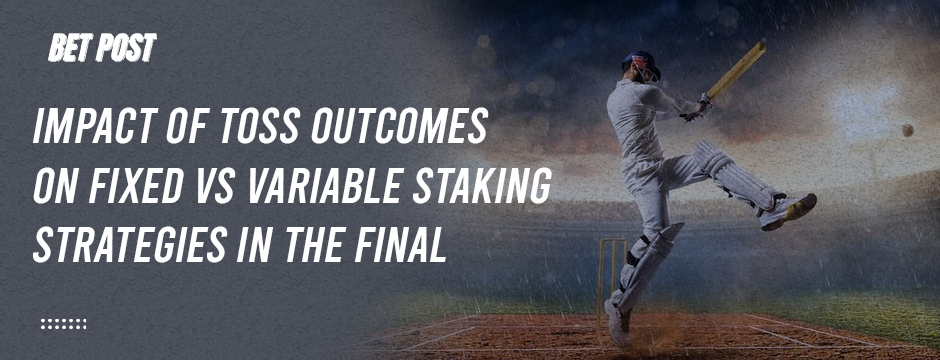Sports betting is a complex game of strategy, and one of the most controversial issues surrounding sports betting is staking strategy, or rather how bettors manage their bankrolls. There are a multitude of ways to bet, but fixed staking and variable staking are by far the most utilised strategies. The outcome of a coin toss or any binary event can have a wide range of outcomes for a bettor from event to event, based on the choice of the staking model employed.
A coin toss is typically thought of as a simple 50/50 proposition, and depending if a bettor utilises a fixed or variable staking strategy, an event can have very different results. Knowing the strengths and weaknesses of each approach to staking is an important consideration for long-term profitability and risk management. This blog post will explore how toss outcomes affect both Fixed vs variable staking strategies, giving bettors options to consider before betting.
Understanding Fixed and Variable Betting Strategies
Fixed Betting Strategy
In a fixed betting strategy, you stake the same amount on each bet, regardless of past performance. This is a safer betting strategy because it reduces your exposure to large losses while still exhausting your bankroll but at a slower rate.
Pros
- Easier managing and calculating returns.
- Reduced risk of losing your entire bankroll.
- Easier for beginners and for those who dislike losing money.
Cons
- Slow growth of your bankroll.
- Does not take advantage of winning streaks efficiently.
- Less ability to adjust to market conditions based on performance.
Variable Betting Strategy
In comparison, a variable betting strategy involves increasing or decreasing the size of your wager based on past results, confidence levels, or a pre-determined betting model. Some of the more common betting models are the Martingale (progressively raising wagers until a win), the Fibonacci betting model, and percentage betting strategies.
Pros
- Higher potential payouts when using a variable model during a winning streak.
- Potentially applied to different betting scenarios.
- If the betting strategy is executed and managed correctly, maximizing the potential to earn a profit.
Cons
- Larger potential losses are based on your predetermined model, especially when using an aggressive betting model.
- Requires greater management of your bankroll.
- Can be mentally exhausting when experiencing a losing streak.
The Impact of Flip Results on Betting Strategies
Flip and Randomness
The Psychological Effect on a coin flip is, of course, a true 50/50 event, so there is no real edge in trying to predict the result of the event. However, when it comes to betting, a streak of flip results (e.g. heads/tails) can create a psychological influence on the bettor’s decision-making process.
For example, bettors who follow variable staking methods might be more inclined to raise their stakes, anticipating that the result will flip in their favour, or detrimentally, flip in or against their favour if they are on a winning streak. This is particularly a danger under a Martingale betting strategy because losses can accumulate quickly if the streak continues.
Fixed Stake Strategy
A Save method of Toss BettingWith a fixed stake strategy, a bettor will bet the same amount each toss, while “mitigating” or neutralizing the value of a streak of toss results – whether the streak is favourable or unfavourable for the bettor. The benefits are:
- Garnering protection from emotional betting.
- Maintaining consistent bankroll management.
- Achieving a contracted, slower and steadier return on investment.
However, the drawback is that in a fixed stake strategy, the gambler is not opportunistically taking advantage of streaks; which would be perceived with high-risk, high-reward strategies.
Variable Staking Strategy: Following Wins or Losses
Variable staking can be greatly affected by the results of the toss. For example, consider the Martingale strategy. In this situation, the bettor doubles their bet each time they lose. If the bettor goes on a long losing streak on their toss bet, they would eventually be required to stake a very large portion of their bankroll. Eventually, the bankroll would be gone or depleted.
Other forms of variable staking, like the Kelly Criterion, involve betting a percentage of the bankroll according to the perceived value of the bet. This model will weigh the size of the stake on wins and losses, providing better long-term sustainability compared to the Martingale, yet still being exposed to variable staging volatility.

Comparing the Outcomes of the Two Staking Strategies
Examining two Fixed vs variable staking can illustrate the primary distinctions:
- Fixed Staking: A bettor betting $10 for every toss over 100 tosses can expect a fixed amount back depending purely on win/loss percentage.
- Variable Staking (Martingale): A bettor starting to stake $10 per toss that loses five bets in a row now must bet $320 on the next toss.
- Variable Staking (Kelly Criterion): A bettor bets 5% of their bankroll per toss. This is contingent, on maximizing bankroll sustainability based on winning/losing streaks in the long run.
Information indicates that fixed staking is a lower-risk strategy that may not provide high profits in a short time; contrasted with variable stakes which can increase returns, but has the potential for catastrophic loss if not implemented properly, although can increase profits if done in a disciplined manner.
Which strategy should you use for tossing bets?
- For casual bettors: Fixed staking is the best option because it maintains consistent bankroll management.
- For aggressive bettors: While variable staking can be profitable, you must have disciplined management of the betting process.
- For pro bettors: Hybrid approaches that include percentage staking or modified Kelly Criterion, offer the best combination of risk versus reward.
Final Words
The outcome of the toss will have a large influence over betting strategies, especially if comparing a Fixed vs variable staking model. Fixed staking offers a steady preservation of your bankroll, whereas variable staking can provide higher rewards with more risk. Bettors should adopt a staking model that best suits their risk appetite, experience, and betting strategy. If you want to learn more about strategy and betting tips Visit Betpost for all your betting analysis and wise betting tips.
Ready to put your staking strategy to the test? Explore smarter betting options and live toss outcomes on GoFun88—where strategy meets opportunity.






